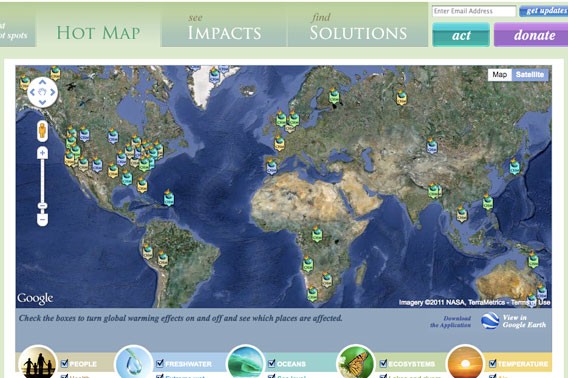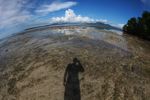
Screen shot of the new Climate Hot Map. Screenshot of Climate Hot Map from the Union of Concerned Scientists (UCS).
A global interactive map has been developed by the Union of Concerned Scientists (UCS) to highlight climate impacts already occurring worldwide. From glacier melt risking water supplies in Bolivia to coral bleaching off the coast of Florida, the Climate Hot Map employs the best in climate science to bring home the impacts of global warming.
“One of the main goals of the map is to really bring the science of climate change to life by connecting it to people’s daily lives around the world,” explained UCS climate scientist Brenda Ekwurzel in a press release. “That’s the part of climate research that’s sometimes hard to get from scientific publications.
The map, which will have updated impacts every month, shows climate change impacts in five categories: terrestrial ecosystems, temperature, freshwater, oceans, and people, which includes threats to food supplies, the economy, and public health.
Users can also find out how to decrease their own emissions under Find Solutions.
“Once you find out about your own region, you start to get interested in other regions that are facing global warming consequences. We think a map will make it easier for people to get the big picture of what’s going on around the world,” Ekwurzel adds.
According to decades of research from thousands of scientists, the world is warming because of emissions of greenhouse gases from human actions, such as burning fossil fuels and destroying forests. During the 20th Century, the global average temperature rose about 1.33 degrees Fahrenheit (0.74 degrees Celsius). Future warming depends on how rapidly global society brings down current emissions. Expected impacts from climate change include more frequent and worsening extreme weather events, greater precipitation events (both rain and snow), worsening droughts for parts of the world, global sea level rise due to polar melting, large-scale species extinctions, ocean acidification, a rise in massive fires, changes in the range of diseases, and many others. Water supplies, food production, societal health, the global economy, and international stability are all expected to be threatened by climate change.
Related articles
The truth about polar bears and climate change

(06/21/2011) Although scientists say innumerable species are threatened by climate change, polar bears have been the global symbol of the movement to reign-in greenhouse gas emissions. This is perhaps not surprising, since polar bears are well known to the public—even though they inhabit a region largely absent of humans—and they make a big impression. Their glaringly white coat contrasts with their deadly skills: as the world’s biggest terrestrial predators, they are capable of killing a seal with single blow. When young they are ridiculously adorable, but when adults they are stunning behemoths. But that’s not all. Unlike many other species, the perils of climate change are also easy to visualize in connection with polar bears: their habitat is literally melting away.
Ocean prognosis: mass extinction

(06/20/2011) Multiple and converging human impacts on the world’s oceans are putting marine species at risk of a mass extinction not seen for millions of years, according to a panel of oceanic experts. The bleak assessment finds that the world’s oceans are in a significantly worse state than has been widely recognized, although past reports of this nature have hardly been uplifting. The panel, organized by the International Program on the State of the Ocean (IPSO), found that overfishing, pollution, and climate change are synergistically pummeling oceanic ecosystems in ways not seen during human history. Still, the scientists believe that there is time to turn things around if society recognizes the need to change.
Current carbon releases faster than at any time on record
(06/13/2011) The Paleocene-Eocene Thermal Maximum (PETM), a period of global warming that occurred nearly 56 million years ago due to massive releases of greenhouse gases, is frequently referenced as an analogue for projected climate change. However, recent findings suggest the current rate of carbon release is almost 10 times as rapid as at the peak of the PETM—and that biological systems may be significantly less able to adapt.